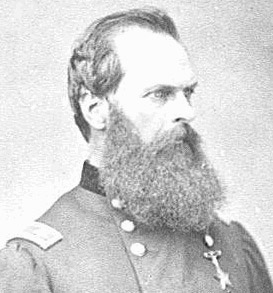Pennsylvania in the Civil War
Virtue ~ Liberty ~ Independence
John White Geary
1819
- 1873
![]()
|
|
Born: Died: Education: |
Pre-War
Professions:
John
Geary was a student at Jefferson College in Canonsburg, Pa., when the death of
his father forced him to begin adult life early. He tested a number of
professions before settling on law: Teacher, store clerk, surveyor in Kentucky
and several other states; and engineer and assistant superintendent on the Alleghany Portage Railroad.
Upon
the break out of the Mexican War, John Geary volunteered his services as a
soldier, and was named Lieutenant Colonel of the Second Pennsylvania Regiment.
On September 2, 1846, he led the regiment against Chapultepac Castle, and his regiment was the first to arrive inside the alls of Mexico City. In recognition, General Quitman appointed him commander of the
Citadel during the occupation of the city1.
Following
the war, on January 22, 1849, President James Polk rewarded his heroism by appointing him to the office
of Postmaster at San Francisco and Geary, with his wife, Margaret, and son, Edward, left for the west coast, arriving there in April 1849. As Postmaster, he had the power to create post offices, appoint postmasters, establish mail routes, and make contracts for carrying the mails throughout California. He later became a member of the State Constitutional
Convention at Monterey.
Upon
the election of Zachary Taylor as president, Geary was superseded as
Postmaster; however, he was unanimously elected first alcalde of the city by
its citizens in August 1849. The following year, under the first city charter,
he was chosen mayor of San Francisco on May 1, 1850. General Geary served one
year as mayor, then returned to Pennsylvania in 1852 on a six-months leave of
absence to visit his family and friends. Soon after Geary's return home, his
wife and several near relatives died, and he abandoned the idea of returning to
California. As a parting gift, he gave the city the land that later became
Union Square. Geary Street in San Francisco is named for him.
In
July of 1856, General Geary was appointed Governor of Kansas. His strong
antislavery views forced his resignation after numerous confrontations with
pro-slavery forces.
Civil War Service
In
June 1861 Colonel Geary immediately issued a call in his home state for troops;
so well respected was he that 68 companies responded to his proclamation. Geary
selected 15 and organized the oversized 28th Pennsylvania Infantry, which
included Knapís Independent Artillery Battery E.
Service
with Brigadier General Nathaniel P. Banks along the upper Potomac River (Harper's
Ferry, Bolivar Heights, Leesburg ) resulted in his commission as Brigadier
General of Volunteers on 25 April 1862. In August of that year, he commanded the
1st Brigade/2nd Divison of the II Corps at the Battle of Cedar Mountain where
he was wounded in the foot and shoulder. Yet this tall, full-bearded officer
with sharp eyes and an equally sharp tongue soon returned to duty and assumed
command of the 2nd Division in the XII Corps. Troops under his command participated
in the Battle of Chancellorsville, were instrumental in repulsing the
Confederates at Culp's Hill at Gettysburg, and displayed extraordinary valor at
Lookout Mountain.† †
During
the fighting at Wauhatchie, Tenn., his son, Edward R. Geary, 1st Lt.
Knapís Independent Battey E, was killed by a rebel bullet on October 29, 1863.
In
William T. Sherman's Atlanta Campaign, Geary commanded the 2nd Division of the XX
Corps, and Shermanís subsequent March to the Sea.†
Following the surrender of CSA General Joseph
Johnstonís Army of the West
to General Sherman, General Geary served as
military governor of Savannah.
While
serving in this position, he received a brevet promotion to Major General.
Post-War:
In
1866, General Geary, a Republican, was elected Governor of Pennsylvania; he
served two consecutive terms, from 1867 to 1873. On February 8, 1873, less than
3 weeks after leaving the governors post, Geary, age 53, was fatally stricken while
preparing breakfast for his infant son. He was buried with state honors in
Mount Kalma Cemetery, Harrisburg, Pa.
A
battlefield statue of Mayor Geary, as a general in the Union Army, was erected
in 1915 at Gettysburg. The State of Pennsylvania erected the monument, but it
was never dedicated. The reason is not known.
Honors::
Geary
Street in San Francisco is named for John White Geary.
Geary
County was originally named "Davis County" in 1855. For several years
after the Civil War the citizens of Davis County complained about living in an
area named for the President of the Confederate States of America, even though
he was Secretary of War when the county was named for him. In 1889, the
county's name was changed to honor John W. Geary, Governor of Kansas Territory
(1856). He was also Mayor of San Francisco (1850), General, U. S. Army
(1861-1865), and Governor of Pennsylvania (1867-1873).
Further Reading:: Geary,
John White A politician goes to war : the Civil War letters of John White
Geary . University Park PA, Pennsylvania State University Press, 1995. Sources:
Library of Congress Civil War Section Web Site
William G. Cutler. History of the State of Kanas, Part 42, Territorial History.
John
White Geary History Marker Web Site: http://www.mtpleasantpa.com/gearyt.html 
. Edited by Patricia L. Faust
1McLaughlin, Philip. Historical Times Encyclopedia of the Civil War
The Museum of the City of San Francisco Web Site
Geary County, Kansas, USGenWeb Project Web Site
![]()
Return to Officers
Return
to Pennsylvania in the Civil War
pacivilwar@pa-roots.net
Sign our Guest Book
